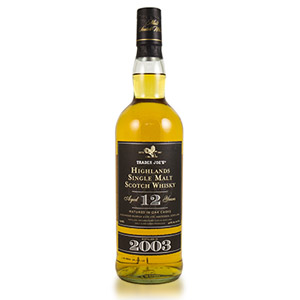There has been an interesting thread on David D’s K&L Spirits Blog recently regarding the much-talked-about boom/bust cycle in whisky. His opinion, based on comparisons to the continuously overinflated Bordeaux wine market, is that the whisky industry may have broken out of the boom/bust cycle and prices may be on a perpetual increasing trajectory. I’m certainly no expert – and David has a lot more insider knowledge and first-hand experience with the market than most anyone around – but as a customer I really want to believe that a bust is coming. What follows is half my opinion and half wishful thinking.
I like to think that the cause of the historically established whisky bubble/bust cycle is twofold. One, the law of supply and demand coupled with the lengthy aging process of whisky. Two, the capriciousness of public opinion and global taste trends.
First, supply and demand plays a funny role in scotch. Traditionally, because it costs a lot of money to produce spirit and, more importantly, age it (the costs of barrels, storage space, and taxes on aging whisky) distillery managers had to estimate the future demand for their whisky based on historical data in order to produce the “right” amount of new make. Also traditionally, distilleries always got this wrong. If nobody’s buying whisky right now, it hardly makes sense to push the stills to the max and cram the warehouse with barrels that are going to cost a lot *now* and then wait for some hypothetical future boom cycle to recoup those costs. Even when extra whisky is produced during a bust cycle, those excess barrels are generally sold off to blenders (at a price just high enough to keep the lights on), or to speculators in the independent bottling business. Distillation and aging are expensive, and potential future gains don’t pay today’s bills.
Conversely, when whisky is popular and mature barrels are flying off the racks, distilleries become flush with capital and begin to upgrade equipment, expand production, start research & development operations, implement wood management programs, increase efficiency, and generally make more new-make whisky to age. That’s where we are right now. There’s going to be a lot more whisky racked in warehouses and rickhouses in 10 years than there is now.
The nature of supply and demand means that IF demand decreases between now and the ten-or-so years it takes to mature all this new-make (or fails to increase proportionally to the increased production output), THEN the excess supply in ten years will drive prices down. So will demand decrease? That brings me to point number two.
Luxury spirits, like many other niche luxury industries, rely on trends. When you have young drinkers in Japan enjoying blended scotch highballs, American yuppies sipping and hoarding rare bourbons, and trendy European nightclubs serving Ardbeg cocktails, those brands all benefit, and this ripples out to attract people who want to understand and participate in the current hot trend. When the category is not so happening – like 20 years ago when scotch was an old man’s drink and bourbon meant Jim Beam and Jack Daniels – demand plummets.
It’s also worth noting that the high end of markets like whisky and wine are supported by the volume of the low end. There is a lot more Charles Shaw, Beringer, and Yellowtail sold globally each year than first-growth Bordeaux. There’s a whole lot more blending whisky and low-end bourbon sold than Talisker 25, Brora, and Pappy. IF the bottom were to fall out of one of those markets – consider today’s global demand for sherry for instance – the prices of the higher end products would likely have to change to reflect the sinking demand for the category as a whole.
Of course, today’s whisky companies are aware of all this and are doing their best to counteract the effect. By slowly eliminating age statements from the public’s perception of quality, they can begin selling whisky (perhaps vatted together with older stock) at a younger age and short-circuit the bust cycle. By advertising, holding tastings, and running promotions, they seek to instill a sense of brand loyalty in new drinkers that could support a coming bust. My opinion is that, at best, these are mitigating efforts that will help keep distilleries from shuttering when the bust comes, but are not going to free the industry from the cycle.
At some point five, ten, twenty years down the line, it will no longer be cool to drink whisky. Terroir artesian spring waters? Vintage sake? Gin cocktails? Who knows what will be next, but it will make all of those massive stocks of aging scotch look like more of a tax burden than a smart investment for the future. Who knows, if wine suffers the same perceived drop in trendiness… “Bordeaux? Please, that’s what my parents drink. I’m into craft ciders….” we could see a reversal in prices there, too. Remember that people said the housing market would increase forever, and that we’d broken out of the real estate cycle. My wallet and I are both hoping that today’s $1 house in Detroit is a harbinger for tomorrow’s $30 two-for-one sale on The Macallan “Ruby”.



Good analogy to real estate near the end. Scotch is a discretionary purchase. No one needs to buy scotch. Demand doesn’t even really have to drop much for prices to come down, people just have to decide they won’t pay that much.
When the American real estate crash happened, there was no major reason for it, prices just got too high and people decided they didn’t need to buy right now and then prices dropped. Once prices started falling, sellers began to drop their prices below comparables to get a sale.
The same could happen with whiskey. Supply goes up, people decide $90 is too much to pay for a certain bottle and go for a cheaper bottle, or even worse, don’t buy anything at all, and ta da, prices have to start coming down to lure consumers back to higher quality whiskeys.
It all depends on customers ability and willingness to pay higher prices.
i just started trying different whisky’s (i’ve never drank any other types of liquor before so i just thought i’d try whiskey)and if the prices are just going to increase should i even bother with it?i’ve read quite a few posts on forums and in a few years prices have doubled on allot of the whisky’s i have looked at.i don’t quite like any of the whisky’s i’ve tried yet (i’m not used to alchohol) but if i start to like it and in a few years prices double agian it would be extremely expensive to buy bottom shelf whisky’s.i’d like to hear your opionion if you can comment.
Drake,
This is a tricky question. Should you avoid the entire market because prices are going up? That comes down to your personal taste. If you’re excited by whisky and enjoying the discovery of it, then I would not let the price increases dissuade you. Analogous to this is the wine market of 10 or so years ago – many French wines, for example, were affordable luxuries that caused a lot of people to get excited by the entire world of wine. Now, those French wines are out of the grasp of most modern consumers. Those people didn’t stop drinking wine, though, they just found cheaper ways to enjoy it. If 18 year-old single malts routinely climb into the $200+ range, that means it’s time to start enjoying 12 year-olds at $50+, or even get into whiskies from other parts of the world. Also, there’s always a chance of a market crash when people get sick of paying elevated prices… but there’s no guarantee of that. I suggest continuing to try to find whiskies you enjoy at the lower end of the range (try Bank Note blended whisky). Good luck and cheers!
yeah i’m enjoying trying different whiskys right now,most of the ones i have tried are too strong for me but i like w l weller special reserve and knob creek,i’m not used to the burn yet but i’ll get there.i have only tried bourbon and rye whiskey so far but i’m going to try to find some small bottles of glenlivet 12 , glenfiddich 12 , jameson and maybe some bushmills black bush to try differnt things.
i also wanted to say your reviews are very helpfull and they help me decide what i should try next.thanks.
As much as I hate the price hikes (there’s many a video game gone unpurchased to make room in the single malt budget), I will say one upside to being in a whisky boom cycle is the willingness of distillers to take chances and experiment in ways they probably wouldn’t in a bust cycle. When you’re distillery is struggling to survive, you’re probably going to hold off on gambles like Tokaji or Calvados casks.
I think this is a great post. I think the key that ties together real estate and whisky is the relatively fixed supply of both (at least in the short to medium run). Without a flexible supply, moderate changes in demand can effect large changes in price very quickly.
Gasoline is the same way, but with the addition of demand holding relatively fixed (inelastic). It requires a fairly large change in price to effect a marginal change in quantity demanded. In the long run people can buy more fuel-efficient cars, gas companies can dig more wells, etc, but these things take time – just like putting more spirit into casks.
As someone who drinks but does not collect whisky, I hope you are right. 😉
Great points Michael, thanks!